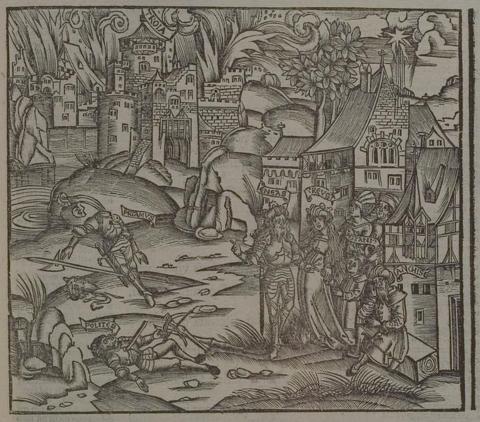Annotations
On the right side of the image, Aeneas, Creusa, Ascanius and a few servants stand next to a seated Anchises and attempt to persuade him to flee Troy with them (651-54). On the left lie Polites and headless Priam, pitiful reminders of what will happen to the family of Aeneas if they stay; Aeneas mentions the king and his son while begging his own father not to stay behind. In the upper right corner, a storm cloud and a shooting star signify that Anchises has agreed to leave his home (692-4). In the upper left, Troy continues to burn. (Katy Purington)
Woodcut illustration from the “Strasbourg Vergil,” edited by Sebastian Brant: Publii Virgilii Maronis Opera cum quinque vulgatis commentariis expolitissimisque figuris atque imaginibus nuper per Sebastianum Brant superadditis (Strasbourg: Johannis Grieninger, 1502), fol. 178r, executed by an anonymous engraver under the direction of Brant.


Sebastian Brant (1458–1521) was a humanist scholar of many competencies. Trained in classics and law at the University of Basel, Brant later lectured in jurisprudence there and practiced law in his native city of Strasbourg. While his satirical poem Das Narrenschiff won him considerable standing as a writer, his role in the transmission of Virgil to the Renaissance was at least as important. In 1502 he and Strasbourg printer Johannes Grüninger produced a major edition of Virgil’s works, along with Donatus’ Life and the commentaries of Servius, Landino, and Calderini, with more than two hundred woodcut illustrations. (Annabel Patterson)